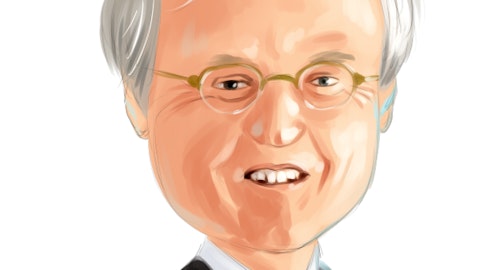Robert Griffin: Okay. Very helpful. I guess 2 final questions for me. I mean, 1, tax refunds off to, I guess, there’s some commentary out there, a little bit of delay. So just anything there you guys are seeing for us to keep in mind. And then two, just on the BrandsMart side of things, if we’re kind of in this environment of rough comps or kind of tough comps, is there further cost to be removed there to kind of help maintain the EBITDA profile? Or is it really just revenue dependent on getting EBITDA margins back up to kind of the mid-single-digit level or low single-digit level?
Douglas Lindsay: Sure. I’ll take tax season, the first. As you know, refund season just started, and we’ll provide more detail on our Q1 earnings call, which will be right around the corner. But tax season is a little delayed on starting. I’m sure everybody is aware of that. And we’re just starting to get in some impacts of checks being released here.Our 2024 outlook assumes that this year’s tax season will be similar to last year’s and as you know, tax season is never over until it’s over. And we expect that because it’s similar to the last year, we should see similar payment activity and early purchase options as we did last year. In regards to BrandsMart, we continue to look to optimize the cost structure. But ultimately, you’re right, it’s going to really be about top line demand and winning share in this market.
The marketplace for appliances and electronics has been challenging, and we’re forecasting demand to improve over the course of the year. A bright spot is the new store we opened and Augusta is off to a good start. And as we mentioned earlier, we’re going to open another store in the back half of this year. We really believe in the growth opportunity — market growth opportunity at BrandsMart and the compelling brand positioning that we have in South Florida and Georgia, in particular. The 4-wall economics of these stores are very compelling, and we can layer this on top of our existing store support and corporate overhead structure. And we believe when demand does improve in the second half of the year, we’ll see great flow-through. Steve and his team have done a really good job on managing costs and improving margin in that business.
And ultimately, it’s going to be a top line story going forward.
Operator: Our next question comes from Kyle Joseph of Jefferies.
Kyle Joseph: Just want to — obviously, it sounds like Aaron’s was consistent with your expectations, BrandsMart lagging and don’t get me wrong, we understand how difficult consumer retail is right now. But in your perspective, is that a function of the customer base at the respective stores? Or is that kind of a function of the discretionary nature of the purchases between the 2? What’s really driving the variance in performance in recent periods?
Stephen Olsen: Kyle, this is Steve. I would say it’s a combination. One is these being durable goods that we really drive at BrandsMart appliances, consumer electronics and furniture, but the breakdown of that is really between transactions and ticket is what’s driving the decline in comparable sales. So that’s about, call it, 2/3 of a mix on transactions and then 1/3 on ticket.
Stephen Olsen: Kyle, you did bring up kind of the difference between our lease-to-own business and BrandsMart, which is a pure retail business. And again, we’ve talked about this in the past, our Aaron’s business has the benefit of being a portfolio business. So we’re originating these leases and then customers are renewing them and we’re receiving payments over time, which is providing a bit more consistency.So when you see growth in demand in general for consumer durable goods, you see greater growth on a pure retail company than you would typically in a lease-to-own business. And the same thing happens on the downside. And again, part of that, as you mentioned, is related to the customer mix. Most of our customers on the lease-to-own side, it’s more of a needs-based kind of transaction. They need a new refrigerator, they need new furniture. They don’t have access to traditional payment options, and so we’re there to meet their needs.
Kyle Joseph: Got it. Very helpful. And then one follow-up for me for Douglas. On credit, I know you talked about write-offs being a function of ecomm growth, but aside from that, any changes to underwriting or kind of the outlook for the health of your consumer?
Douglas Lindsay: No changes really. We continue to say we continue to optimize our decisioning model. Obviously, the rollout of this one decision model across all of our origination channels has been very helpful in approving customers and our algorithms and models continue to slope risk and continue to be predictive. So we have great confidence there, and I’m really happy with what we’ve done there and continue to do.In terms of the consumer, Kelly said it right. I mean, Aaron’s model has been really resilient. We’ve seen our — the Aaron’s customer be very resilient as a needs-based customer. If you look at our recurring revenue written in the portfolio, which was down in the mid-4% range as compared to retail, we feel like the business has hung in there pretty well.
As Kelly said also, in terms of pull forward of demand, Aaron’s didn’t have as much pull forward in the stimulus aided period, and so we don’t expect as much relief there, albeit we do expect to relief. But most of the ups, we think, will be more materially seen in the BrandsMart business. But BrandsMart continues to be challenging going into Q1. We are expecting 3% comps, favorable comps at BrandsMart in Q1 and in sequential — I mean, I’m sorry, for the full year of ’24 and sequential improvement throughout the year, but we are expecting Q1 EBITDA at BrandsMart to be negative due to these demand trends.




